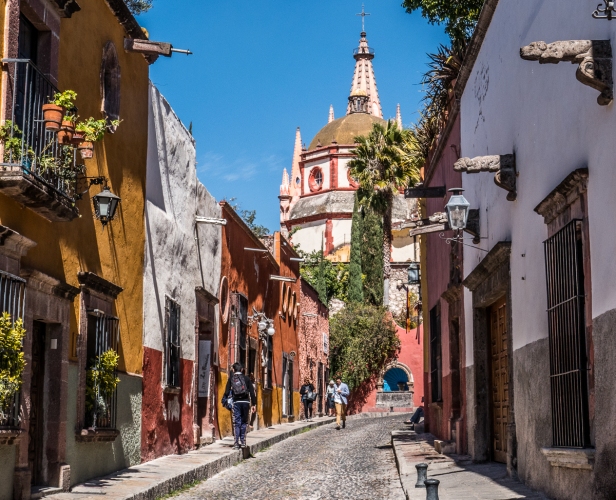
7 Jan– 4 Apr 2016. In San Miguel de Allende (SMA) we lived in the colonia, or neighbourhood, of Infonavit Allende. It’s out past the famed Fabrica La Aurora, a hive of antique stores and artists’ studios housed in a converted and renovated former textile factory. From our home on Calle Ignacio Aldama it was a five-minute walk to the end of the street where it joins the main road. From the main road we could get a taxi or walk into the Centro where most of the cafes, shops, restaurants, bars, and theatres are located.
There are about three hundred taxis in San Miguel and they continually roam the streets. To wait as long as ten minutes is unusual. They don’t have metres. A taxi anywhere in town costs forty pesos. That’s about $2.50 in our money. If it’s late at night or a very busy time the driver might charge fifty pesos. At first we tried to bargain, but after a few futile efforts we just accepted the going rate. Apart from late nights (which we almost never experienced anyway) or busy times, it was always forty pesos. In the beginning we’d ask how much? in our best tourist Spanglish. Always the answer was forty pesos. Soon we were asking cuarenta? And the driver would say si. After a while we’d just have the forty pesos ready and hand it over.
The other way we could to get to town was to walk through the narrow winding cobbled streets of neighbouring Colonia Guadelupe. It takes about twenty minutes to walk to town through Guadelupe, but some days it took us much longer as we constantly stopped to look at and photograph the street art.
Colleen Sorenson, an American expat living in SMA, wanted to deter SMA’s youth from vandalizing the town’s unadorned walls with graffiti. She saw the walls as an opportunity for art rather than defacement; her vision was to legalise graffiti. There was much deliberation with the Director of Tourism, other municipal authorities, and local residents. Local, national, and international graffiti artists were recruited. Obtaining the necessary permits gobbled up years, but finally the first street art festival was held in Guadelupe in 2012. Guadalupe has since been named a Districto de Arte, and the Festival, now in its fourth year is known as Muros en Blanco or The Festival of White (or blank) Walls.
As we stroll along the streets we see hummingbirds, butterflies, dragons, flying fish, flowers, ducks, bulls, skeletons, seahorses, trees, musicians, a flying horse, and much more. At every turn there is something different to see. Different styles, colours, content; some beautiful, some surprising, some puzzling, but all fascinating. Here is a small selection. Some are of the whole mural, some are details. In some I’ve taken liberties with the colours in editing, but most are as they appear.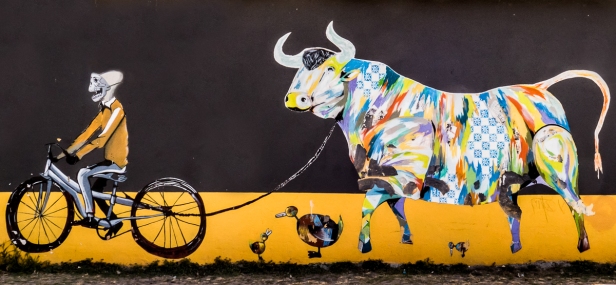
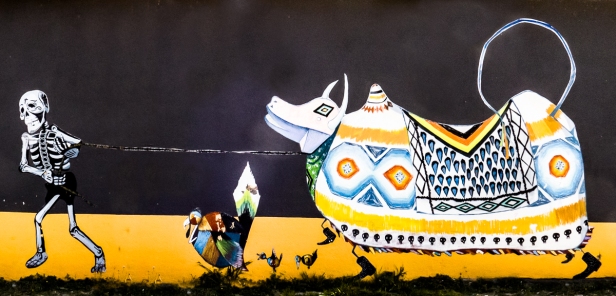
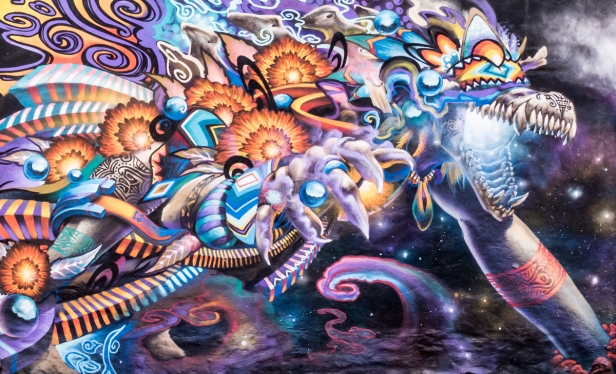
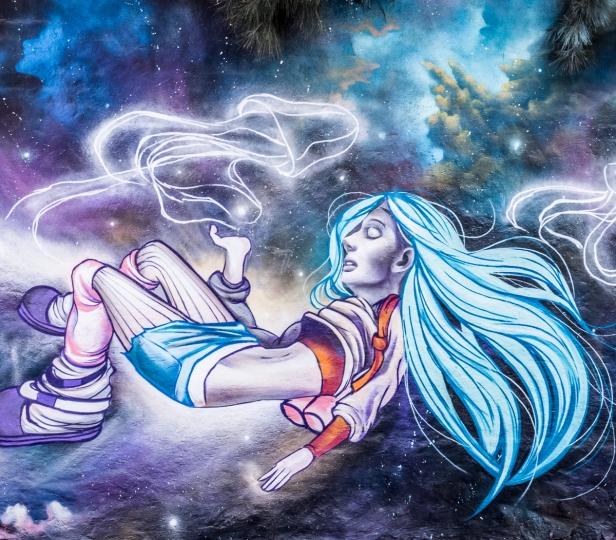

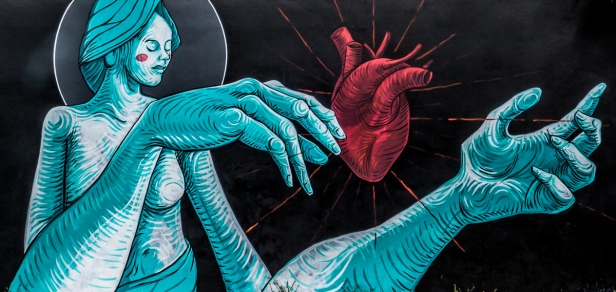
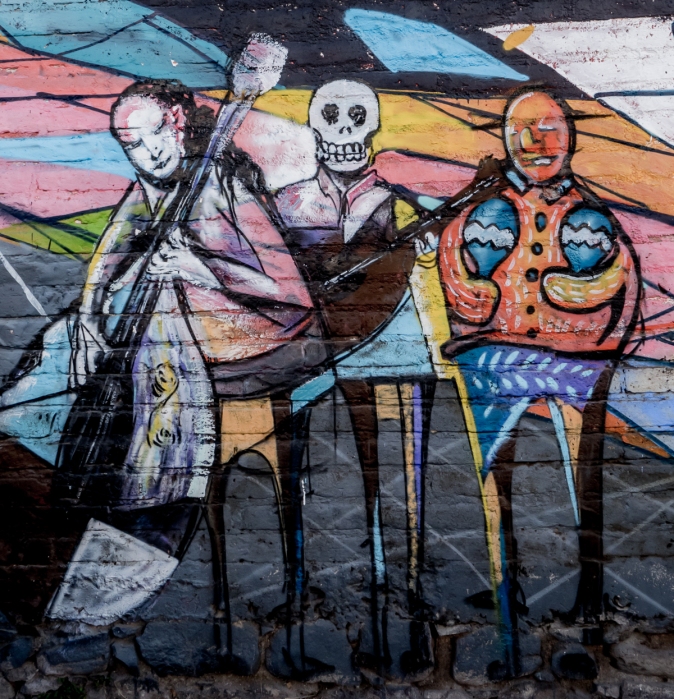


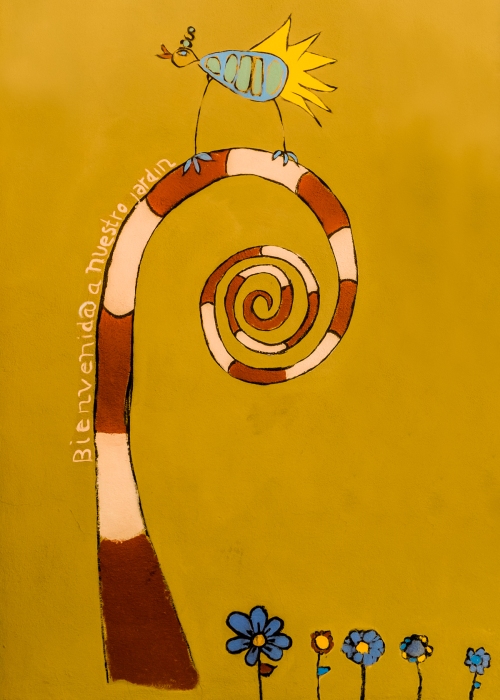
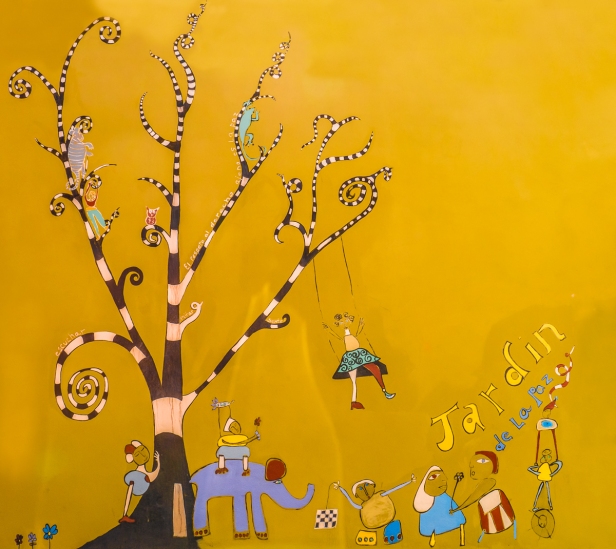

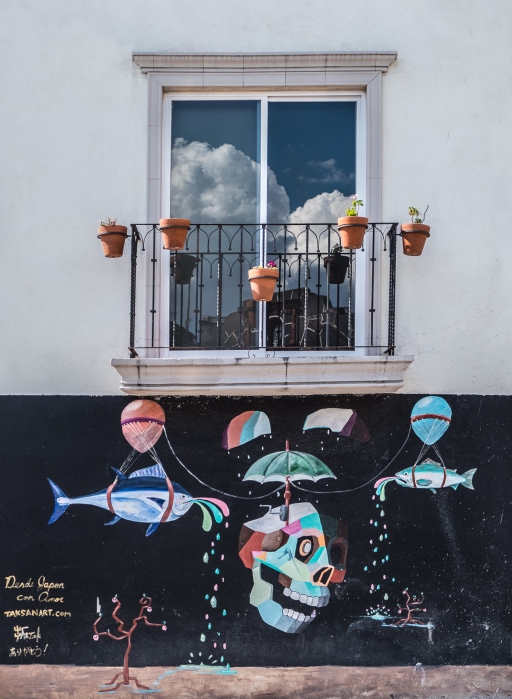

If you go through the front entrance of the Hotel Sautto, on Calle del Doctor Ignacio Hernandez Macias, in SMA’s World Heritage Centro you’ll find yourself in a large leafy courtyard. Turn immediately right onto the dining terrace, and then immediately right again into the small bar. Stop at the bar to put your name on the list for the movie, reserve your seats and order your drink – beer or wine or pop. With drink in hand continue on through the bar to a tiny courtyard. Go through the courtyard and on your left you will find the entrance to the smallest theatre in the world, the Cine Bacco. There are four rows of comfortable seats accommodating a total of twenty-five people. Once seated you’ll be asked if you want popcorn and if yes a small bag will be delivered to you during the first couple of minutes of the movie. Each movie is introduced by a well-informed and enthusiastic European gentleman, one of SMA’s many expats, who has created a small business sharing his passion for films. Total cost $5.
We saw several movies at Cine Bacco including The Danish Girl and The Big Short. There is also another tiny movie theatre in SMA called the Pocket Cinema. We never did get to see it since it was closed while we were there. I think they were having lease problems, though it seems to have reopened now.
If you wander the streets of the Centro there is a soothing sameness to the sheer walls of rich ochre and rust, with the patina and earthiness of bygone times. The buildings seem to have a grounded certainty, and a timeless majesty. Then, as you walk, there are sudden vignettes as churches, lace-curtained windows, a curved street, or an elaborate doorway, entice the eye with contrasting views.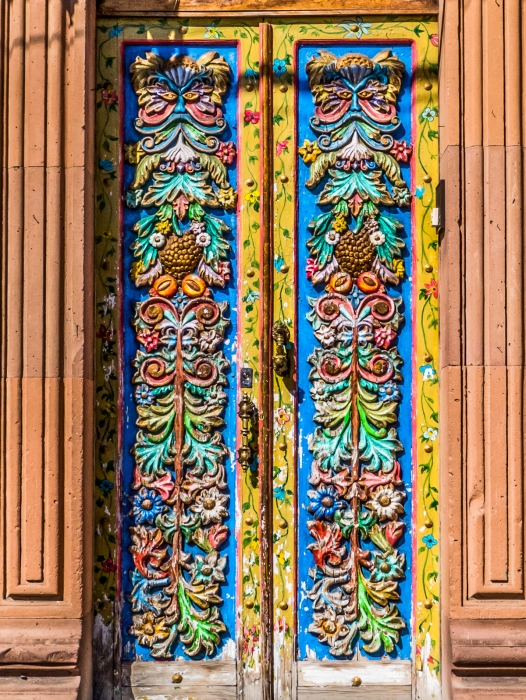
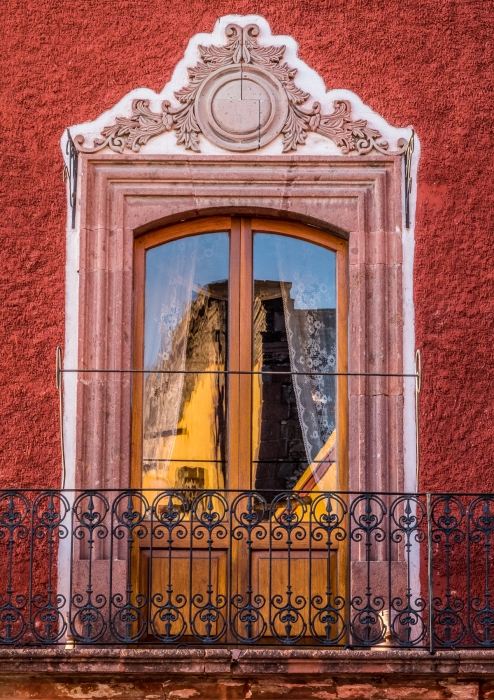
From some viewpoints it seems as if there are buildings piled upon buildings,
while from others the unexpected use of sea foam green paint draws the eye. It’s an ever-changing kaleidoscope of architectural beauty that lands quietly in the heart.
Although ten percent of the population of SMA are expats from the USA, Canada, and Europe, and there’s no doubt that over the years this segment of the population has had a profound affect on the flavour of the town, it is still first and foremost a Mexican town with a Spanish colonial heritage. We saw many expats, and met a few, but it is the Mexicans with their love of colour, community, and family, and their open friendly nature, that light up SMA.


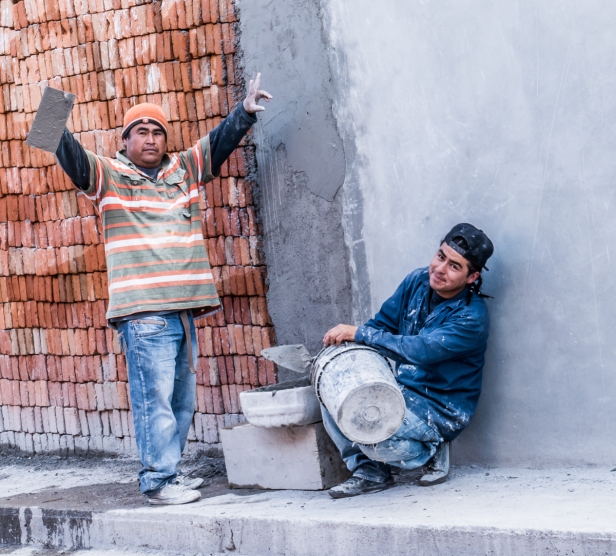
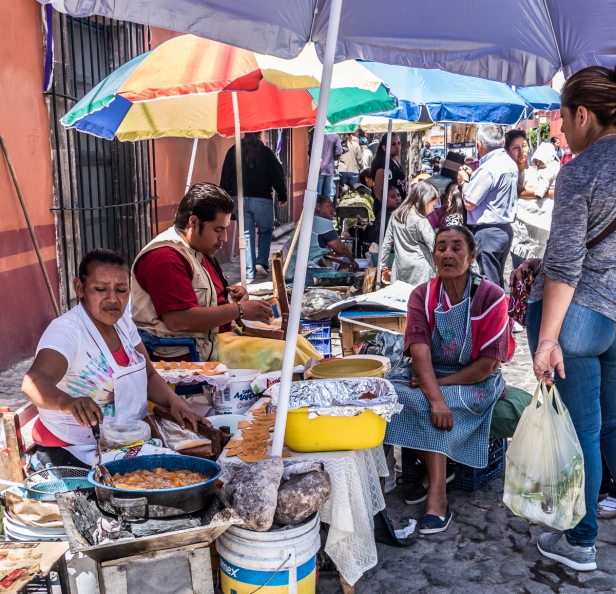
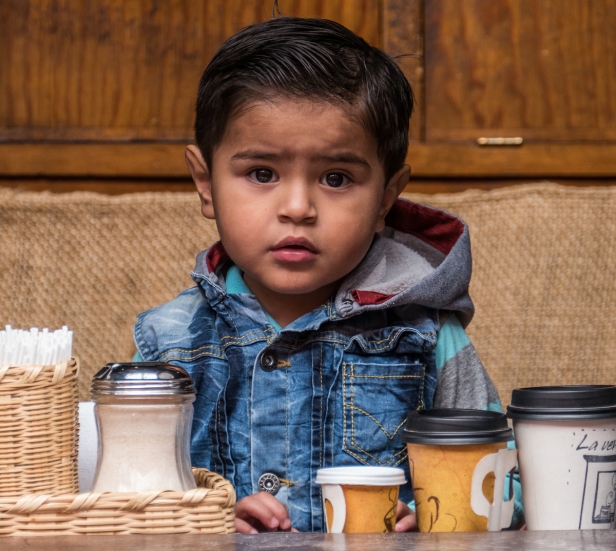

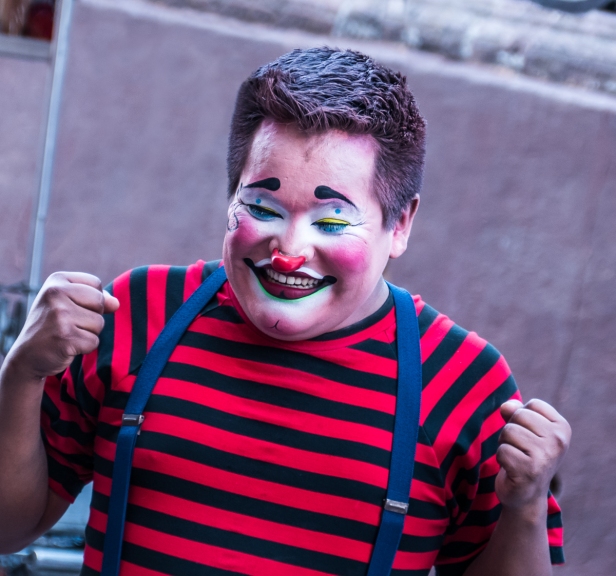



A dancer at one of the many fiestas,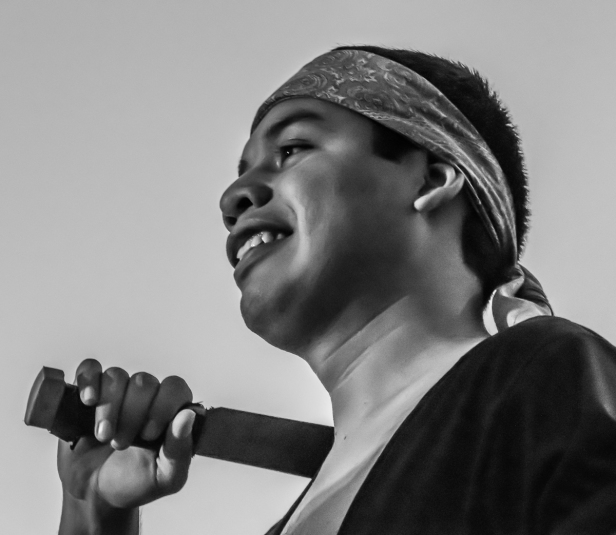
some tourists,

and the bell ringer high up in the towers of La Parroquia. There are four bells, and four bell ringers, and they haul those bells around by the large wooden “handles”. It must take great strength, stamina, and no fear of perforated eardrums! At times we heard the bells ringing for twenty minutes or more.
Having previously spent time in Mexico we found there was no great adjustment to living in SMA. It’s an easy place to live. We speak a little Spanish and the people are enormously friendly. Because of the large expat community everything we wanted was available, though some items, such as a lemon squeezer, took a little searching out.
There’s a decent grocery store called Bonanza in the Centro. If we were running low on anything we could usually get it there. Several days a week a fruit and vegetable market would appear. It was in an empty space about half way down our street, hiding under huge tarps strung overhead to ward off the sun. Heading in the direction of Guadelupe near the high school there’s a small tienda, and a bigger one just a little further away, where we would pick up fresh vegetables from time to time. Once a week we’d take a taxi to Mega, a large American-style supermarket out on the edge of town, where we could get just about anything we wanted including Häagen Dazs.
Sometimes that was all I wanted.
Next post: a spectacular Indigenous festival in the Jardin, and the many parades of Holy Week.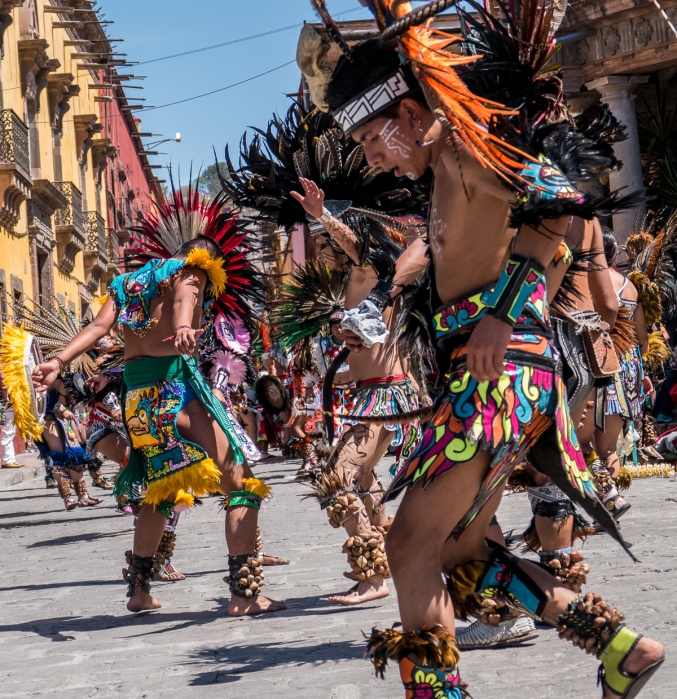
All words and images by Alison Louise Armstrong unless otherwise noted
© Alison Louise Armstrong and Adventures in Wonderland – a pilgrimage of the heart, 2010-2016.

What vibrant and exciting colors! The first and second photos of the murals are my favorite. There’s something intriguing about murals painted with black and yellow/orange colors. SMA does look like a very pleasant and picturesque town! And your photos do this place justice, Alison.
LikeLiked by 1 person
Thanks Bama. I too love that mural – the first and second photos. It’s actually one long mural. I love the whimsy of it, and the colours. SMA is a beautiful vibrant town.
Alison
LikeLiked by 1 person
Ok…now you really must write the post on editing!! I think I remember one of those streets if the first one is near the monastery?? Loved the meander through SMA. But again, those photos! Especially the one with over-sized face and woman walking. The last one and all its not-quite-Alison color. But my favorite is either the blue guy on the roof or the woman holding the baby with leaves above or the red wall with window and yellow door.
LikeLiked by 1 person
Thanks BF. One day I’ll write about editing though I’m hardly qualified. I’m not sure about the street – we were not aware of any monastery, though I didn’t get out much. I know that photo faces towards the Jardin, but I can’t remember exactly where.
You have chosen some of my favourite photos too – the huge face mural, and the woman holding the baby, the red wall/lace curtained window. The guy on the roof was leaning over painting those white squiggles with his fingers. Whatever he had in mind didn’t work. We came by a couple of days layer and it was all painted over with the blue paint.
Alison
LikeLiked by 1 person
I was in SMA many years ago, decades, so anything is possible. Maybe I just liked believing I recognized the place, eh?
LikeLiked by 1 person
What did you mean about the not-quite-Alison colour? Because it’s bit over saturated? Yeah I think it is a bit, but their outfits really were eye-popping in all their fluorescent glory. Or was it something else?
A.
LikeLike
Yeah, but I don’t think it’s over saturated at all. I like the colors and the saturation. Seems perfect to me. It’s just that I’m enamored by your usual photos that downplay color. Or meld it all together sometimes. It’s an Alison thing…you have your own recognizable style. And my ego is pissed and upset about this.
LikeLiked by 1 person
I have a style? I mentioned that to one of my (professional-photographer) sisters once and she snorted – you don’t have a style. But perhaps it was because she’d just been immersed in a six month teaching in Paris with a renowned photographer and it was all about her finding her style. Perhaps she couldn’t swallow it that I found mine early and easily. I have no idea. You never see your own work the way others see it. And I am still excited to sit with my sister while she teaches me stuff. I learned all I know from her and my other (professional photographer) sister.
I do think you have your own style – the things you choose to photograph, and the way you see them. Sometimes I’m wowed by the particular view of something you’ve chosen – that I wouldn’t have thought of! Then I get pissed and upset 🙂
A.
LikeLike
Of course you have a style. The Alison style. It has your name all over it. Some of your photos look almost monochromic, as though everything in the shot was one color…I love the way you do that (or maybe everything was that color?). I also remember one shot of a flower, where there was the slightest color and everything else disappeared sort of…remember that shot, I asked about it. And that sunflower recently…wow, that is art, and your sister is probably biting her lip right now over that one, poor thing.
And I think you’re right, I have my own vision, but I lack the new technical skills so necessary in digital. Film was something else, you got the shot or you didn’t. I’ve had to train myself to take photos differently than before.
LikeLiked by 1 person
Okay sometimes I’ll change the colour of something to match the rest of the image – it’s always like I’m looking at a painting and the content has to be cohesive and the colours have to work together so nothing’s jarring. Sometimes it really is almost monochromatic like the two kids under the umbrella above. I do remember the flower photo you’re talking about. I took it in the Botanic Gardens in Canberra and I’m not sure what I did to get that effect. It’s always an experiment. I love when something like the sunflower emerges. I don’t think my sis has seen it. See I didn’t have a clue, not a clue, with film photography. Well I never did film photography. For most of my life I didn’t even own a camera.
Alison
LikeLike
Changing the color…yeah, well, that explains it…and that’s your style, your eye sees things that way. Luckily you can paint the proper color in with your dang LR brush! I thought about absconding with the sunflower photo and using as my desktop image…it’s so Van Goghish. When I first started taking photos on my first trip to…ahem…Yugoslavia in 1969, I had a Kodak Instamatic. Everyone else had real cameras, but they were envious of my automatic piece of crap. I learned to frame and take only the best shots. Now, I shoot anything and pray for one to be good, but things are not as predictable with digital.
LikeLiked by 1 person
beautiful photos!
LikeLiked by 1 person
Thanks so much Jeremiah and Joanna. Your own photos are pretty amazing!
Alison
LikeLike
As expected, but even moreso it seems, your images stun me! It is not just the colour nor the compositions but your capturing of HUMAN EXPRESSION that has the impact. You know how to photograph eyes and gesture to very telling effect. Lots of eyes we can’t see but we can feel their emotion e.g. the distinctive 3 women tourists and the girl and boy absorbed in the phone. Keep up the communicating Alison.
LikeLiked by 1 person
Thank you so much Ian. I love photographing the people in the places we visit – they are the life of the place, and as you say it’s not always about having them looking into the camera, but about capturing human moments. These moments seem to jump out at me.
Alison
LikeLike
Alison, we spent a week in SMA and loved it. Your photos and post capture the feel of the place exactly. Luckily, our small apartment was close enough to the center that we could walk most places and that was nice. I love all the graffiti art. We didn’t see so much of that when we visited. Graffiti seems to be a part of modern culture, and it’s good to see the effort channeled into good art instead of out of control tagging. ~James
LikeLiked by 1 person
Thanks James. Don walked all over SMA, though me not so much. I was in a lot of pain back then so I rode in taxis a lot, though obviously I did some walking. It’s such a beautiful town. We were well situated to see the street art as they were in the colonia between our place and town. I just started today following a beautifully curated blog about street art around the world. It has indeed become a thing.
Alison
LikeLike
What a beautiful city. I love your description of going to the movies—so simple and civilized. The graffiti art photos are wonderful and I am in awe of the talent. I’ve forwarded this post and your last SMA post to Mike as I think we’d both really enjoy visiting this city (and it gives us more inspiration for the photo course we’re currently doing). I’ll remember to stock up on 40 pesos. Thanks Alison for a warm, sunny start to my morning (as long as I keep my eyes on the computer screen!)
LikeLiked by 1 person
here here
LikeLiked by 1 person
Thanks Caroline. This is a small collection of the street art that we saw. There is tons of it, and as I was doing research for this post I saw photos of many that we didn’t come across in our wanderings. SMA is a beautiful city. Hope you get there one day!
(I’m not even looking out the window! – We were hoping for a walk today. Maybe later in the afternoon. We’re staying near the endowment lands – the forest is calling me.)
Alison
LikeLike
As usual, your pictures are amazing and capture the flavour of this town. No matter where the Spanish people live, there is colour! The graffiti murals are great!
LikeLiked by 1 person
Thanks Darlene. It’s true about the Spanish, and their influence – vibrant colour. And I think that was a natural fit with the indigenous people who also revel in vibrant colour. Everywhere we’ve been in Latin America it’s the same. No one is afraid of colour – it’s the opposite! I love it. A lot of things I’m moved to photograph is because the colour grabs me
Alison
LikeLike
Alison I really have run out of descriptors for your photos. So I will say this. When I come upon your posts and am immersed in these gorgeous photos I instantly want to go where you have been. Perhaps that is the ultimate compliment you are the inspirer of wanderlust. I’m a nut for colour. This looks like just the spot.
LikeLiked by 1 person
Aww thanks Sue. I can highly recommend a RL visit to SMA, and make no apology for having inspired you 🙂
I also am a nut for colour. Like I said to Darlene, it’s often what grabs me when I’m out photographing. The Indian festival (next post) was eye-popping for colour.
Alison
LikeLiked by 1 person
Wow! That street art and the photos of them are absolutely incredible. I’ve been there looong time ago, I really want to go back.
LikeLiked by 1 person
Thanks Mani. So you know the beautiful charm of SMA, but yes, the street art is relatively new I think. I hope you get back there one day and see it for yourself.
Alison
LikeLike
Although you had a rough start there, your post certainly highlights the many positives of this quaint little town. I remember so well the walk from the fabrica area to the center of town, as well as the earth-toned streetscapes accented by bright colors and the warm people. I don’t remember much of the street art, probably because I was there before it really took off. Love the photos, especially those with the soft canterra stone.
LikeLiked by 1 person
Thanks Lex. It’s a beautiful town isn’t it. It’s hard to not be caught in its charm, even if I wasn’t doing so well at the time. We walked into town so many times past the same buildings on the main road, and the same art in Guadelupe. I loved the earth-toned streetscapes. One day in Guadelupe we saw three guys working on a new mural. I don’t remember which one it was now.
Alison
PS I had to look up canterra stone lol.
LikeLike
About 10 years ago we were semi-serious about relocating part-time to SMA, so we looked at some houses there – hence, I learned the name of that wonderful porous canterra (actually, I see it’s cantera after looking it up myself) stone that is used for all the buildings! I love the way it holds color and almost seems to breathe.
LikeLiked by 1 person
Such intriguing posts and great photography, thank you! I’ve heard about San Miguel for a long, long time and have always wanted to go spend time there. If you can offer a suggestion about how to search for long-ish term accommodation that’s fairly inexpensive I would greatly appreciate it. 🙂
LikeLiked by 1 person
Thanks Shellie. I too had heard about SMA for many years before I finally got there for the first time. It was worth the wait. I hope you get there one day. We used airb&b for accommodation. I think it’s as good a way to go as any. Plus you might find something here:
http://www.atencionsanmiguel.org/classifieds/
Hope this helps.
Alison
LikeLike
Thanks very much, Alison, appreciate it. 🙂
LikeLiked by 1 person
Wow, great colors! The streets, the paintings, the people – the whole thing reeks of character. It must have been an interesting stay.
LikeLiked by 1 person
Thanks Dave. I *loved* the colours. Colour grabs me every time. Yes – oodles of character in this town. It was very interesting, and even though I was dealing with a lot of pain, we still managed to get out and about quite a bit, to several festivals, and the movies, and we went to a couple of sessions at the Writers festival. SMA is really quite special.
Alison
LikeLiked by 1 person
Great photos, vibrant colours.. I like the most the little boy looking in all his innocence, straight into your camera. Lovely!
LikeLiked by 1 person
Thanks Christie. That little boy was there with his parents in their hole-in-the-wall coffee shop. Maybe they can’t afford daycare. He’s so beautiful, and yes, so innocent.
Alison
LikeLiked by 1 person
Wow! Your pictures are amazing, especially the street art. Great read as well. Thanks for sharing. 👏🏼💯
LikeLiked by 1 person
Thanks so much. The street art in SMA is pretty incredible – and this is only a very small sample of what’s there.
Alison
LikeLiked by 1 person
Alison, as always you have beautifully captured the essence and soul of a place with your amazing pictures.
LikeLiked by 1 person
Thanks Gilda. SMA oozes soul, so I was constantly inspired to photograph things, people, places. It’s charming and colourful and vibrant, with always lots going on.
Alison
LikeLike
The street art is fantastic and you captured some great people shots too. Love your story telling!
LikeLiked by 1 person
Thanks Debbie. We loved the street art and on a couple of days went looking for pieces we may have missed by walking our usual route into town. And we still didn’t see it all. As always I realize after I’ve published that there are more stories I could have told. This happens to me every post! In this one I forgot to mention that the tattooed man has “American Original” tattooed above his eyebrows! He is certainly that. And that the white squiggles that the man high up on the roof was painting on the wall were all painted over a couple of days later. I still can’t figure out why he was doing that. Perhaps it was an experiment that didn’t work.
Alison
LikeLiked by 1 person
That guy with the tatoo is amazing – I can’t help to think how painful that would have been.
LikeLiked by 1 person
Yeah, really!
LikeLike
I’m with Caroline I love the small cinema story .
Alison again great information, a story and as always stunning photos to delight our eyes. My faves this time
– the mural shots for their variety and just because I love art and the story of the Festival of the Walls
– the classic of the two blokes working on the wall, love the texture of brick wall too
– the two WINDOW shots especially the one with the mural and the reflection of the clouds but one in the red ochre wall and the reflection of the yellow ochre wall – I love that one
– the one with the man with the painted clown face is gold – such a universal shot – showing happiness and joy and our love of fun.
Keep ’em coming Alison please. Louise
LikeLiked by 1 person
Thanks Louise. That small cinema was such a delight. And we saw some good movies too! We went looking for murals. There’s so many of them, and more added every year. I have photos of murals that I didn’t include because they didn’t appeal to me aesthetically, but almost all were very well executed even if the content and colours weren’t to my taste. Those two blokes working on the wall – their reaction to being photographed is so typical of Mexicans – really open and friendly. I also love the two window shots – reflections will get me every time. There were two clowns, but this was the best shot I got. They were hilarious even if we couldn’t understand them. As you say that kind of humour is pretty universal.
Alison
LikeLiked by 1 person
What a lovely town Alison, captured so well by your photos. As you know, I can’t resit murals. The last with the large face is particularly powerful.Also found the colorful character with his Apple quite amusing. –Curt
LikeLiked by 1 person
Thanks Curt, and yes, it is a lovely town. I’m not surprised that so many retire there. The murals are fabulous, and this is only a small selection. That face blew me away – very powerful. And that guy in Starbucks – I couldn’t believe it. I’ve never seen anything like it. Did you notice he has “American Original” tattooed above his eyebrows?
Alison
LikeLike
I missed the American Original but now I will certainly go back and check! –Curt
LikeLiked by 1 person
Probably everyone missed American Original. I forgot to mention it in the post. It happens to me *far* more often than I like – I publish a post and then realize there was so much more I could have written! Almost every time! I get a little frustrated with myself 🙂
There’s a little story behind almost all of the photos of the people that I could have shared. It’s a lesson for the future!
Alison
LikeLike
It’s a frustration I share, Alison. There is always a question of what to include and what to leave out, not to mention what is forgotten. 🙂 –Curt
LikeLiked by 1 person
My problem is sometimes what I’ve though of, but then forgotten to include, but it’s far more often with things I didn’t even think of until it’s too late. And then I’m like Oh sh*t, why didn’t I think of that!
A.
LikeLike
Ah, the ‘Oh sh*t” clarified that. 🙂 –Curt
LikeLiked by 1 person
🙂
LikeLiked by 1 person
Thanks for sharing those magical photos! Some of my best ones are also from SMA. I would return any time for many reasons, one of which is the incredibly beautiful, innovative and inspiring art.
LikeLiked by 1 person
Thanks so much Helga. SMA’s a wonderful town. After spending a few months there, even though I was going through a hard time, I can see why you’d want to return.
Alison
LikeLike
As always I love your photography and writing, Alison! Although we went to Fabrica la Aurora, we did not walk through the neighborhood with all the street art! What a great reason to go back! Also never went to Cine Bacco, but we did go to the pocket theater once. That was when my ears were so badly blocked and I could barely hear, so as fun an idea as the theaters are, it was not enjoyable for me! Maybe next time I’ll have good hearing! We love SMA and are looking forward to going back! So glad we got to meet you and Don there and also see you in Vancouver! Knowing you gives me joy.
LikeLiked by 1 person
Thanks so much Kaye. Yes, you must go back to see the street art! It’s as good an excuse as any to return. This is a small selection of what we saw, and on top of that there were many we didn’t see. Too bad the Pocket Cinema wasn’t such a good idea for you. That could be another reason to return! Us too – so glad we got to meet you both in person. Maybe again one day!
Alison
LikeLike
Wow! What a stunning place with beautiful photos! You’re photos on this one especially took my breath away. I wanted to tell you which photo was my favorite, but in the end, I couldn’t discredit the others! So many incredible images. It sounds like a relaxing and enjoyable time in Mexico! Oh, and the sneak peak image for your next post…I’m crazy to see all about the festival 😀
LikeLiked by 1 person
Thanks Stephanie. SMA is an amazing place. We love Mexico. We’ve been three times now, once for a week, once for 4 months, and once for 5 months, and have always had a good time. Well, I was struggling with some painful stuff in SMA, but that was not Mexico’s fault. It was a good place to start healing. The people are helpful and friendly, and SMA’s definitely a special town.
Alison
LikeLiked by 1 person
After this post, I looked back at your other posts and realized that you been overcoming a few hurdles at the time. I truly hope that you have found your healing and relief from whatever demons were trailing behind you.
LikeLiked by 1 person
Just love the colours and especially the little door way. Looking forward to your write up on India…one of my favourite places.
LikeLiked by 1 person
Thanks Jo. The colours in SMA, and actually just about everywhere we’ve been in Mexico, are just fabulous. It’s one of the things I love about it.
There are 23 (!) posts about India here:
https://alisonanddon.com/category/india/
The next post is about a festival of the indigenous population in SMA. As in the USA, the indigenous people are referred to as Indian because Christopher Columbus called them that way back when he landed in North America and thought he arrived in the East Indies.
Alison
LikeLiked by 1 person
Fabulous photos! Fabulous street art! World class. I love, love street art…bringing talent and creativity to the streets, free and for the masses. Best concept. Instead of behind closed walls of museums and galleries….
I particularly like the yellow ochre ones. My favorite.
Fabulous post Alison!!
Yogyakarta had some pretty cool street art too…
http://www.greenglobaltrek.com/2014/03/jogyakarta-indonesia-city-life-vs-village-life.html
Peta
LikeLiked by 1 person
Thanks Peta. I must admit there’s a lot of street art that I’m not fond of – the ones that just look like scribbled graffiti rather than being a well thought out piece of art. Most of the ones in SMA were done by artists and although I didn’t like them all, each was a cohesive piece. I looked at your post, and Jogja sounds pretty amazing but I was not taken with the street art there. Maybe I just like neat (as in tidy) stuff too much 🙂
I love the yellow ochre ones too but I will disclose they are the ones where I played with the colour. In real life the background is closer to taupe, and they are three details of the one large piece. In the courtyard of my massage therapist’s house in SMA was a large ‘painting’ of a section of this mural. It had the same bright ochre background that you see in my photographs. I asked about it and they told me where it was. When I found it on the street I was quite surprised to find the taupe background. Clearly they’d photographed it, changed the background colour, and had it enlarged and framed. Anyway that’s where I got the idea from. They are far more beautiful with an ochre background 🙂
Alison
LikeLike
I just had a second, more thorough look at your pics of Jogja street art – and yes, there is some *very* cool stuff there!
A.
LikeLike
Ha ha I hear ya… call it artistic license…changing the tone to something more favorable. I think what we really enjoyed was the seeing the MASS ~ the collection, the sheer volune of everywhere you turn doneone was bring creative. Yogyakarta is a “young” city in that it has a lot of students and artists who reside there, giving it that edgy feel. Thank goodness, as we were coming from Bali and it was wuite a culture shock!
Peta
LikeLiked by 1 person
Volune = volume
Doneone = someone
Apologies for the typos. Ipad related…..
LikeLiked by 1 person
Yes, I got it. Your iPad is very inventive 🙂
A.
LikeLike
Your opening photo is beautiful, Alison – Makes me want to rent a house, pack a suitcase and stroll those colorful streets! So many photos to enjoy (especially the street art and kids) but the picture of the three “mature” women in hats with a parasol looking at a tourist map really stood out – maybe because I know the feeling of being lost in a new town! Anita
LikeLiked by 1 person
Thanks Anita. SMA’s a beautiful town, well worth a visit, though be careful you just might end up living there! Apparently it’s not uncommon for people to arrive there and after about three days start looking for property. The photo of the three women – it was the colour that caught my eye. I’m always drawn to colour and there they were – the parasol, the blue hat, the green bag, and the multi coloured dress. And they were posed so nicely without even knowing it.
Alison
LikeLike
It does look like they posed! Anita
LikeLiked by 1 person
Wow, so much color and art! Wonderfully captured!
LikeLiked by 1 person
Thanks Kelly. Mexico’s amazing for colour! Well pretty much all of Latin America is. I think it’s one of the things I love most about it. That and the enormously friendly people.
Alison
LikeLiked by 1 person
nice pic! love it!
LikeLiked by 1 person
Thanks Biro. It’s a pretty special place.
Alison
LikeLike
Wow, I am speechless when reading and scrolling through your post. The image of the tattooed guy with Mac is phenomenal! Was he aware when you took his picture? Keep capturing the uniqueness of this planet and its humans 🙂
LikeLiked by 1 person
Thank you so much Indah. I was astonished by the tattooed man. He has American Original tattooed above his eyebrows. Well he certainly is that. He was not aware of me taking his picture.
Alison
LikeLike
Fantastic photos! Really give off the feeling of the place
LikeLiked by 1 person
Thanks so much. I’m glad you enjoyed it. SMA’s a very special place.
Alison
LikeLike
After reading this post, hubby and I both agree another visit to SMA is in order. I love the beautiful doors and windows. You have captured the essence of the city with some of your photos of locals…bella!
LikeLiked by 1 person
Thanks LuAnn. It’s such a special place, in so many ways. I wish I’d been in a better space to enjoy it more, but SMA, being what it is, shone through anyway.
Alison
LikeLiked by 1 person
beautiful expression of your holiday, Alison!
and i’m quite impressed with you skills at capturing
revealing moments. your skills at capture discreetly,
without disturbing the moment are impressive. do you pull out the point and shoot quickly, or is that camera hidden in your hat. thank you for bringing me so close to SMA 🙂
LikeLiked by 1 person
Thank you David for your kind words.
I am a sneaky photographer with a long lens and sometimes I hide behind Don 🙂
My camera is actually quite big; not paparazzi big, but bigger than a point & shoot.
Alison
LikeLike
Thanku for taking us to this place
LikeLiked by 1 person
You’re very welcome. I’m glad you enjoyed it. I love to share the wonderful places we go to. And thank you for following.
Alison
LikeLiked by 1 person
Oh my, this is such a visual feast!! Can’t get enough of the vibrant art. The lace curtained window with the delicate ironwork is a standout! Alison, you might have just pushed Mexico back to the top of our list again.
LikeLiked by 1 person
Thanks so much Madhu. Mexico is fabulous. I highly recommend it. We’re about to head back down there, to the Yucatan which we haven’t seen yet. And to Cuba which I’m very excited about. I hope you get to Mexico one day.
Alison
LikeLike
Wow. Those first several graffiti pics – the fantasy ones – are absolutely amazing. In one of my next lives I really want to be able to create art with my hands – draw or paint or sculpt or something. Such beauty!
Also, the pic of the little boy behind the coffee cups is one of my favorite people pictures to date. 🙂
LikeLiked by 1 person
Thanks Felicity. We loved the graffiti. Well most of it anyway. I photographed much more than I’ve included here. I only included the ones I like 🙂
The little boy was “helping” his parents at their hole-in-the-wall coffee shop. Such beautiful innocence.
Alison
LikeLike
I love the colours and the feeling of warmth and community…I love this post Alison 💙 all of them…I imagine doing this one day too…itching to travel ☺️ sending you joy!
LikeLiked by 1 person
Thanks Hedy. The sense of community is one of the things I love about Mexico. We see it everywhere we go. It’s very strong there. And the people are enormously warm and friendly. I hope you get to travel again soon.
Alison
LikeLike